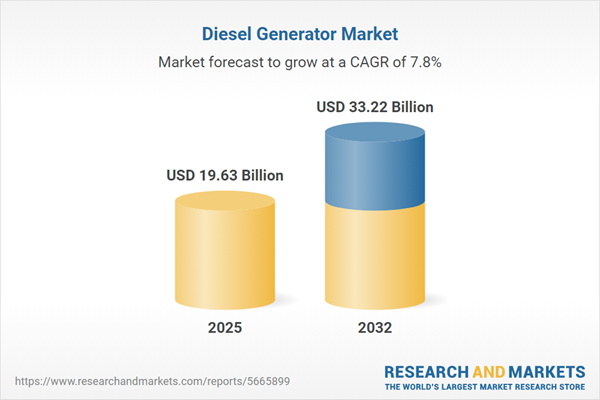Speak directly to the analyst to clarify any post sales queries you may have.
Enterprises are reassessing backup power strategies as energy reliability risks and regulatory pressures mount. The diesel generator market is central to resilience planning, enabling senior leaders to ensure operational continuity and meet compliance expectations across diverse business landscapes.
Market Snapshot: Diesel Generator Market Growth and Dynamics
The global diesel generator market is forecast for significant expansion, with a valuation at USD 18.21 billion in 2024 and an anticipated rise to USD 33.22 billion by 2032, representing a projected CAGR of 7.80%. Factors driving adoption include heightened investments in backup and standby power, the ongoing digital transformation of businesses, and infrastructure modernization. Regulatory requirements are also prompting a range of organizations—including those in manufacturing, commercial, and residential sectors—to upgrade mission-critical assets. The adoption of advanced generator technologies is improving both reliability and flexibility, positioning the diesel generator market as a core enabler for resilient energy strategies and adaptive risk management.
Scope & Segmentation: Comprehensive Coverage Across the Diesel Generator Market
- kVA Rating: Product lines span a broad spectrum to address the requirements of small enterprises and large-scale industrial operations, offering tailored solutions that fit diverse deployment environments and evolving assurance needs.
- End Use Segments: Key sectors—commercial, manufacturing, residential, construction, mining, and oil and gas—depend upon generator uptime to provide infrastructure resilience, safeguard workflow continuity, and sustain critical services.
- Application Modes: Generators configured for base load, prime, or standby operations offer businesses flexibility to manage consistent power needs as well as contingency events across varied models of operation.
- Cooling Types: Air-cooled units are valued for ease of installation and streamlined maintenance, while water-cooled systems are selected for their durability and suitability for demanding or mission-critical environments.
- Mounting Types: Portable systems enable flexible use onsite or in remote projects, while stationary installations are designed for integrated, long-term supply within business facilities.
- Sales Channels: Options include direct procurement and aftermarket service, with technical support and efficient parts programs helping organizations to maximize asset uptime and respond rapidly to operational challenges.
- Geographic Regions: Market demand varies with urbanization trends, local policy, and infrastructure growth in the Americas, Europe, Middle East, Africa, and Asia-Pacific. Businesses must align with regional energy regulations and adapt to distinct market frameworks.
- Leading Companies: Established providers such as Caterpillar Inc., Cummins Inc., Generac Power Systems, Kohler Co., Rolls-Royce Power Systems AG, Atlas Copco AB, Mitsubishi Heavy Industries, Yanmar Co., Honda Motor Co., and Wärtsilä Corporation deliver differentiated solutions, global reach, and compliance-driven technical support.
Key Takeaways for Senior Decision-Makers
- Building resilient backup frameworks minimizes the impact of unpredictable power disruptions, supporting proactive risk management across the enterprise.
- Integrating digital monitoring systems and AI analytics streamlines asset maintenance, enhancing generator availability and productivity.
- Combining diesel generation with renewables or storage creates hybrid solutions to address regulatory challenges and advance sustainability efforts.
- Flexible procurement and lifecycle programs empower organizations to adopt new generator technologies and quickly adjust to evolving operational requirements.
- Local expertise and a thorough understanding of regional dynamics strengthen compliance and tailor business strategies to unique market needs.
- Modular system designs and comprehensive service offerings help organizations handle variable power demands and optimize asset value.
Tariff Impact: Navigating Trade Policy and Supply Chain Adjustments
Upcoming changes in U.S. tariffs for 2025 are causing organizations to reassess their sourcing and supply chain strategies for diesel generators. Practical measures—such as value engineering, proactive inventory management, and applying for tariff exemptions—are growing in priority for effective cost control. Companies also emphasize agile logistics and regulatory adherence to maintain business continuity and mitigate new risks as trade policies evolve.
Methodology & Data Sources
The report consolidates expert opinions, technical assessments, and end-user perspectives, drawing from official documents, peer-reviewed studies, and verified market intelligence. A rigorous process of data screening, cross-checking, and subject-matter review ensures reliable insights for senior-level decision making.
Why This Report Matters: Strategic Advantage for Senior Leaders
- Receive actionable guidance on regulatory trends, technology innovation, and evolving market conditions to shape business continuity plans.
- Benefit from compliance benchmarking and risk analysis to enhance procurement strategies and reduce exposure to operational uncertainties.
- Leverage credible insights to support decisive leadership during changing power environments and complex supply chains.
Conclusion
Senior decision-makers can use this report to refine backup energy strategies, reinforce operational reliability, and align with sustainability and performance imperatives across dynamic business environments.
Additional Product Information:
- Purchase of this report includes 1 year online access with quarterly updates.
- This report can be updated on request. Please contact our Customer Experience team using the Ask a Question widget on our website.
Table of Contents
3. Executive Summary
4. Market Overview
7. Cumulative Impact of Artificial Intelligence 2025
Companies Mentioned
The companies profiled in this Diesel Generator market report include:- Caterpillar Inc.
- Cummins Inc.
- Generac Power Systems, Inc.
- Kohler Co.
- Rolls-Royce Power Systems AG
- Atlas Copco AB
- Mitsubishi Heavy Industries, Ltd.
- Yanmar Co., Ltd.
- Honda Motor Co., Ltd.
- Wärtsilä Corporation
Table Information
| Report Attribute | Details |
|---|---|
| No. of Pages | 194 |
| Published | November 2025 |
| Forecast Period | 2025 - 2032 |
| Estimated Market Value ( USD | $ 19.63 Billion |
| Forecasted Market Value ( USD | $ 33.22 Billion |
| Compound Annual Growth Rate | 7.8% |
| Regions Covered | Global |
| No. of Companies Mentioned | 11 |









